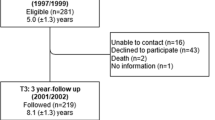Abstract
In this study, we examine the relationship between general education teachers and second- and third-grade included students with autism. We also examine the effect of childrens' behavior problems on these relationships, as well as inclusion within the social environment of the classroom. Included students with autism form multidimensional relationships with their general education teachers. These relationships are associated with student's display of behavior problems and level of inclusion in the class. Specifically, when teachers perceived their relationships with included students with autism to be more positive, children's levels of behavioral problems were lower and they were more socially included in the class.
Similar content being viewed by others
REFERENCES
American Psychiatric Association (1994). Diagnostic and statistical manual of mental disorders (4th ed.) Washington, D. C.
Baron-Cohen, S., & Tager-Flusberg, H. (1994). Understanding other minds: Perspectives from autism. New York: Oxford University Press.
Birch, S. H., & Ladd, G. W. (1998). Children's interpersonal behaviors and the teacher-child relationship. Developmental Psychology, 34, 934–946.
Cairns, R. B., & Cairns, B. D. (1994). Social networks and the functions of friendships, Lifelines and risks: Pathways of youth in our time. New York: Cambridge University Press.
Cairns, R. B., Gariepy, J. L., & Kindermann, T. (1990). Identifying social clusters in natural settings. Unpublished manuscript: Social Development Laboratory, University of North Carolina at Chapel Hill.
Copeland-Mitchell, J., Denham, S. A., & DeMulder, E. K. (1997). Q-sort assessment of child-teacher attachment relationships and social competence in the preschool. Early Education & Development, 8, 27–39.
Giangreco, M. F., Edelman, S. W., Luiselli, T. E., & MacFarland, S. Z. (1997). Helping or hovering? Effects of instructional assistant proximity on students with disabilities. Exceptional Children, 64, 7–18.
Howes, C., Hamilton, C. E., & Matheson, C. (1994). Children's relationships with peers: Differential associations with aspects of the teacher-child relationship. Child Development, 65, 253–263.
Kasari, C., & Sigman, M. (1996). Expression and understanding of emotion in atypical development: Autism and Down syndrome. In M. Lewis & M. W. Sullivan (Eds.), Emotional development in atypical children (pp. 109–130). Mahwah, NJ: LEA.
Marks, S. U., Schrader, C., & Levine, M. (1999). Paraeducator experiences in inclusive settings: Helping, hovering, or holding their own? Exceptional Children, 65, 315–328.
Pianta, R. C. (1992). Student-Teacher Relationship Scale. University of Virginia, Charlottesville, VA.
Pianta R. C. (1994). Patterns of relationships between children and kindergarten teachers. Journal of School Psychology, 32, 15–31.
Pianta R. C. (1997). Adult-child relationship processes and early schooling. Early Education and Development, 8, 11–26.
Pianta, R. C., & Nimetz, S. L. (1991). Relationships between children and teachers: Associations with classroom and home behavior. Journal of Applied Developmental Psychology, 12, 379–393.
Pianta, R. C., & Steinberg, M. S. (1992). Beyond the Parent: The role of other adults in children's lives. San Francisco, CA: Jossey-Bass Inc, Publishers.
Pianta, R. C., & Steinberg, M. S. (1992). Teacher-child relationships and the process of adjusting to school. New Directions for Child Development, 57, 61–80.
Pianta, R. C., Steinberg, M. S., & Rollins, K. B. (1995). The first two years of school: Teacher-child relationships and deflections in children's classroom adjustment. Development and Psychopathology, 7, 295–312.
Schopler, E., & Mesibov, G. B. (1995). Learning and cognition in autism. New York: Plenum Press.
Swanson, J. M. (1995). SNAP-IV Scale. Child Development Center, UC Irvine.
Author information
Authors and Affiliations
Rights and permissions
About this article
Cite this article
Robertson, K., Chamberlain, B. & Kasari, C. General Education Teachers' Relationships with Included Students with Autism. J Autism Dev Disord 33, 123–130 (2003). https://doi.org/10.1023/A:1022979108096
Issue Date:
DOI: https://doi.org/10.1023/A:1022979108096




